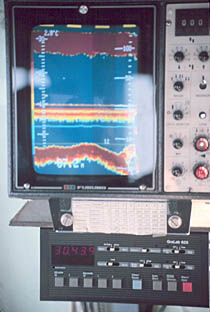
A fishfinder or sounder (Australia) is an instrument used to locate fish underwater by detecting reflected pulses of sound energy, as in sonar. A modern fishfinder displays measurements of reflected sound on a graphical display, allowing an operator to interpret information to locate schools of fish, underwater debris, and the bottom of a body of water. Fishfinder instruments are used both by sport and commercial fishermen. Modern electronics allow a high degree of integration between the fishfinder system, marine radar, compass and GPS navigation systems.

The Fight Between Carnival and Lent was painted by Pieter Bruegel the Elder in 1559. It is a panorama of contemporary life in the Southern Netherlands. While the painting contains nearly 200 characters, it is unified under the theme of the transition from Shrove Tuesday to Lent, the period between Christmas and Easter.
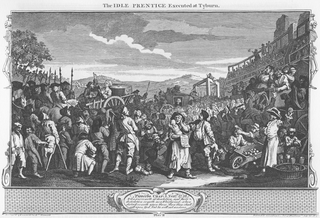
Industry and Idleness is the title of a series of 12 plot-linked engravings created by William Hogarth in 1747, intending to illustrate to working children the possible rewards of hard work and diligent application and the sure disasters attending a lack of both. Unlike his earlier works, such as A Harlot's Progress (1731) and Marriage à-la-mode (1743), which were painted first and subsequently converted to engravings, Industry and Idleness was created solely as a set of engravings. Each of the prints was sold for 1/– each so 12/– for the entire set, which is equivalent in purchasing power to approximately £80 STG as of 2005. It may be assumed that these prints were aimed for a wider and less wealthy market than his earlier works. The originals currently reside at the British Museum.

Four Times of the Day is a series of four oil paintings by English artist William Hogarth. They were completed in 1736 and in 1738 were reproduced and published as a series of four engravings. They are humorous depictions of life in the streets of London, the vagaries of fashion, and the interactions between the rich and poor. Unlike many of Hogarth's other series, such as A Harlot's Progress, A Rake's Progress, Industry and Idleness, and The Four Stages of Cruelty, it does not depict the story of an individual, but instead focuses on the society of the city in a humorous manner. Hogarth does not offer a judgment on whether the rich or poor are more deserving of the viewer's sympathies. In each scene, while the upper and middle classes tend to provide the focus, there are fewer moral comparisons than seen in some of his other works. Their dimensions are about 74 cm (29 in) by 61 cm (24 in) each.

The Course of Empire is a series of five paintings created by the English-born American painter Thomas Cole between 1833 and 1836. It is notable in part for reflecting popular American sentiments of the times, when many saw pastoralism as the ideal phase of human civilization, fearing that empire would lead to gluttony and inevitable decay. The theme of cycles is one that Cole returned to frequently, such as in his The Voyage of Life series. The Course of Empire comprises the following works: The Course of Empire – The Savage State; The Arcadian or Pastoral State; The Consummation of Empire; Destruction; and Desolation. All the paintings are oil on canvas, and all are 39.5 inches by 63.5 inches except The Consummation of Empire which is 51″ by 76″. All five paintings are currently in the collection of the New York Historical Society.
Underwater logging is the process of logging trees from underwater forests. When artificial reservoirs and dams are built, large areas of forest are often inundated; although the trees die, the wood is often preserved. The trees can then be felled using special underwater machinery and floated up to the surface. One such machine is the sawfish harvester. There is an ongoing debate to determine whether or not underwater logging is a sustainable practice and if it is more environmentally sustainable than traditional logging.

Work (1852–1865) is a painting by Ford Madox Brown that is generally considered to be his most important achievement. It exists in two versions. The painting attempts to portray, both literally and analytically, the totality of the Victorian social system and the transition from a rural to an urban economy. Brown began the painting in 1852 and completed it in 1865, when he set up a special exhibition to show it along with several of his other works. He wrote a detailed catalogue explaining the significance of the picture.
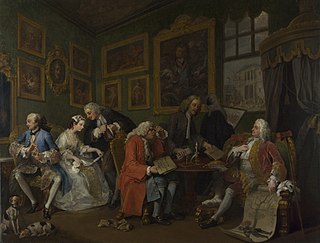
The Marriage Settlement is the first in the series of six satirical paintings known as Marriage A-la-Mode painted by William Hogarth, named after the historical legal arrangement of a Marriage settlement.

The Lady's Death is the sixth and final canvas in the series of satirical paintings known as Marriage A-la-Mode painted by William Hogarth.

The Gate of Calais or O, the Roast Beef of Old England is a 1748 painting by William Hogarth, reproduced as a print from an engraving the next year. Hogarth produced the painting directly after his return from France, where he had been arrested as a spy while sketching in Calais. The scene depicts a side of beef being transported from the harbour to an English tavern in the port, while a group of undernourished, ragged French soldiers and a fat friar look on hungrily. Hogarth painted himself in the left corner with a "soldier's hand upon my shoulder."

Bathers at Asnières is an 1884 oil on canvas painting by French artist Georges Pierre Seurat, the first of his two masterpieces on the monumental scale. The canvas is of a suburban, placid Parisian riverside scene. Isolated figures, with their clothes piled sculpturally on the riverbank, together with trees, austere boundary walls and buildings, and the River Seine are presented in a formal layout. A combination of complex brushstroke techniques and a meticulous application of contemporary color theory bring to the composition a sense of gentle vibrancy and timelessness.

The San Marco Altarpiece is a painting by the Italian early Renaissance painter Fra Angelico, housed in the San Marco Museum of Florence, Italy. It was commissioned by Cosimo de' Medici the Elder, and was completed sometime between 1438 and 1443.

The Chapel of Saint Mary and the Angels is a chapel in one of the bays of the crypt of St James' Church, Sydney, created as a place for younger children to receive an adapted form of the Eucharist on Sundays. In the 21st century, the chapel is used for the children's Eucharist on the first Sunday of the month. The walls and ceiling of the chapel are painted with scenes inspired by the Christmas carol "As I Sat Under A Sycamore Tree" with the setting transferred to Sydney Harbour.

The Baptism of the Eunuch is a 1626 painting by the Dutch artist Rembrandt van Rijn, owned by the Museum Catharijneconvent in Utrecht since 1976. It shows Philip the Evangelist baptising an Ethiopian man, a eunuch, on the road from Jerusalem to Gaza, traditionally marking the start of the Ethiopian Church.
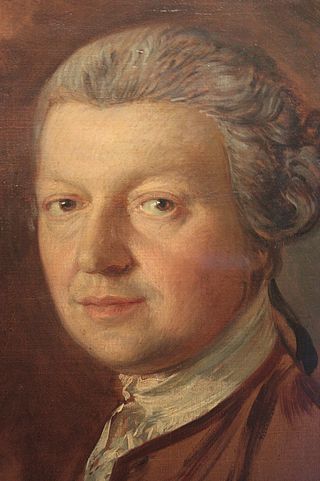
Joshua Kirby, often mistakenly called John Joshua Kirby, was an English 18th-century landscape painter, engraver, writer, draughtsman and architect famed for his publications and teaching on linear perspective based on Brook Taylor's mathematics.

The Stone Bridge is a 1637 landscape painting by the Dutch Golden Age painter Rembrandt in the collection of the Rijksmuseum.
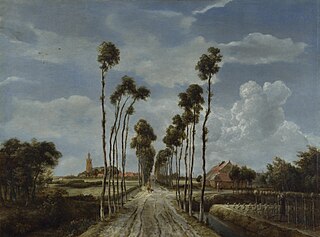
The Avenue at Middelharnis is a Dutch Golden Age painting of 1689 by Meindert Hobbema, now in the National Gallery, London. It is in oil on canvas and measures 103.5 by 141 centimetres. It shows a road leading to the village of Middelharnis on the island of Goeree-Overflakkee in the Meuse delta in South Holland, the Netherlands.

Old Chiswick is the area of the original village beside the river Thames for which the modern district of Chiswick is named. The village grew up around St Nicholas Church, founded c. 1181 and named for the patron saint of fishermen. The placename was first recorded c. 1000 as Ceswican. In the Middle Ages the villagers lived by fishing, boatbuilding, and handling river traffic. The surrounding area was rural until the late 19th century.
Yokohama photographs also known as Herbert Geddes collection or Life in Japan, ca. 1910 is a collection of photographic glass-plate transparencies collected by Canadian Herbert Geddes in the beginning of the 20th century. The collection is stored in the University of Victoria.


















